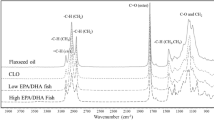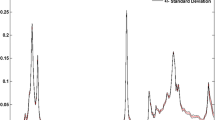Abstract
A rapid analytical approach for discrimination and quantitative determination of polyunsaturated fatty acid (PUFA) contents, particularly eicosapentaenoic acid (EPA) and docosahexaenoic acid (DHA), in a range of oils extracted from marine resources has been developed by using attenuated total reflection Fourier transform infrared spectroscopy and multivariate data analysis. The spectral data were collected without any sample preparation; thus, no chemical preparation was involved, but data were rather processed directly using the developed spectral analysis platform, making it fast, very cost effective, and suitable for routine use in various biotechnological and food research and related industries. Unsupervised pattern recognition techniques, including principal component analysis and unsupervised hierarchical cluster analysis, discriminated the marine oils into groups by correlating similarities and differences in their fatty acid (FA) compositions that corresponded well to the FA profiles obtained from traditional lipid analysis based on gas chromatography (GC). Furthermore, quantitative determination of unsaturated fatty acids, PUFAs, EPA and DHA, by partial least square regression analysis through which calibration models were optimized specifically for each targeted FA, was performed in both known marine oils and totally independent unknown n − 3 oil samples obtained from an actual commercial product in order to provide prospective testing of the developed models towards actual applications. The resultant predicted FAs were achieved at a good accuracy compared to their reference GC values as evidenced through (1) low root mean square error of prediction, (2) good coefficient of determination close to 1 (i.e., R 2≥ 0.96), and (3) the residual predictive deviation values that indicated the predictive power at good and higher levels for all the target FAs.






Similar content being viewed by others
References
Afseth, N. K., Martens, H., Randby, A., Gidskehaug, L., Narum, B., Jørgensen, K., et al. (2010). Predicting the fatty acid composition of milk: a comparison of two Fourier transform infrared sampling techniques. Applied Spectroscopy, 64(7), 700–707.
Armenta, R. E., Scott, S. D., Burja, A. M., Radianingtyas, H., & Barrow, C. J. (2009). Optimization of fatty acid determination in selected fish and microalgal oils. Chromatographia, 70(3/4), 629–636.
Barrow, C. J., Nolan, C., & Jin, Y. (2007). Stabilization of highly unsaturated fatty acids and delivery into foods. Lipid Technology, 19(5), 108–111.
Braeckman, U., Provoost, P., Sabbe, K., Soetaert, K., Middelburg, J. J., Vincx, M., et al. (2012). Temporal dynamics in the diet of two marine polychaetes as inferred from fatty acid biomarkers. Journal of Sea Research, 68, 6–19.
Burja, A. M., Radianingtyas, H., Windust, A., & Barrow, C. J. (2006). Isolation and characterization of polyunsaturated fatty acid producing Thraustochytrium species: screening of strains and optimization of omega-3 production. Applied Microbiology and Biotechnology, 72, 1161–1169.
Burja, A. M., Armenta, R. E., Radianingtyas, H., & Barrow, C. J. (2007). Evaluation of fatty acid extraction methods for Thraustochytrium sp. ONC-T18. Journal of Agricultural and Food Chemistry, 55, 4795–4801.
Connell, A. M., Dunn, M. R., & Forman, J. (2010). Diet and dietary variation of New Zealand hoki Macruronus novaezelandiae. New Zealand Journal of Marine and Freshwater Research, 44(4), 289–308.
Curtis, J. M., Berrigan, N., & Dauphinee, P. (2008). The determination of n−3 fatty acid levels in food products containing microencapsulated fish oil using the one-step extraction method. Part 1: measurement in the raw ingredient and in dry powdered foods. Journal of the American Oil Chemists Society, 85, 297–305.
Falk-Petersen, S., Haug, T., Hop, H., Nilssen, K. T., & Wold, A. (2009). Transfer of lipids from plankton to blubber of harp and hooded seals off East Greenland. Deep Sea Research Part II: Topical Studies in Oceanography, 56(21–22), 2080–2086.
Geladi, P., & Kowalski, B. R. (1986). Partial least-squares regression: a tutorial. Analytica Chimica Acta, 185, 1–17.
Goutte, C. (1997). Note on free lunches and cross-validation. Neural Computation, 9(6), 1245–1249.
Guillén, M. D., & Cabo, N. (1997). Characterization of edible oils and lard by Fourier transform infrared spectroscopy. Relationships between composition and frequency of concrete bands in the fingerprint region. Journal of the American Oil Chemists' Society, 74, 1281–1286.
Indarti, E., Majid, M. I. A., Hashim, R., & Chong, A. (2005). Direct FAME synthesis for rapid total lipid analysis from fish oil and cod liver oil. Journal of Food Composition and Analysis, 18, 161–170.
Kansiz, M., Schustera, K. C., McNaughton, D., & Lendl, B. (2005). Sequential injection/mid-infrared spectroscopic analysis of an acetone–butanol–ethanol fermentation: analyte cross correlation effects. Spectroscopy Letters, 38, 677–702.
Kohler, A., Kirschner, C., Oust, A., & Martens, H. (2005). Extended multiplicative signal correction as a tool for separation and characterization of physical and chemical information in Fourier transform infrared microscopy images of cryo-sections of beef loin. Applied Spectroscopy, 59(6), 707–716.
Kohler, A., Afseth, N. K., & Martens, H. (2010). Chemometrics in biospectroscopy. In E. Li-Chan, P. R. Griffiths, & J. M. Chalmers (Eds.), Applications of vibrational spectroscopy in food science (pp. 89–108). Chichester: Wiley.
Kralovec, J. A., Zhang, S., Zhang, W., & Barrow, C. J. (2012). A review of the progress in enzymatic concentration and microencapsulation of omega-3 rich oil from fish and microbial sources. Food Chemistry, 131, 639–644.
Liu, K.-Z., Shaw, R. A., Man, A., Dembinski, T. C., & Mantsch, H. H. (2002). Reagent-free, simultaneous determination of serum cholesterol in HDL and LDL by infrared spectroscopy. Clinical Chemistry, 48(3), 499–506.
Locher, F., Heuwinkel, H., Gutser, R., & Schmidhalter, U. (2005). The legume content in multispecies mixtures as estimated with near infrared reflectance spectroscopy: method validation. Agronomy Journal, 97, 18–25.
Maggio, R. M., Kaufman, T. S., Del Carlo, M., Cerretani, L., Bendini, A., Cichelli, A., et al. (2009). Monitoring of fatty acid composition in virgin olive oil by Fourier transformed infrared spectroscopy coupled with partial least squares. Food Chemistry, 114, 1549–1554.
Martens, H., Nielsen, J. P., & Engelsen, S. B. (2003). Light scattering and light absorbance separated by extended multiplicative signal correction. Application to near-infrared transmission analysis of powder mixtures. Analytical Chemistry, 75, 394–404.
McDonald, R. E., & Mossoba, M. M. (2002). Methods for trans fatty acid analysis. In C. C. Akoh & D. B. Min (Eds.), Food lipids: chemistry, nutrition, and biotechnology (2nd ed.). New York: Marcel Dekker.
Miller, M. R., Perry, N. B., Burgess, E. J., & Marshall, S. N. (2011). Regiospecific analyses of triacylglycerols of hoki (Macruronus novaezelandiae) and Greenshell™ mussel (Perna canaliculus). Journal of the American Oil Chemists' Society, 88, 509–516.
Naes, T., Isaksson, T., Fearn, T., & Davies, T. (2002). A user-friendly guide to multivariate calibration and classification. Chichester: NIR.
Naumann, D., Labischinski, H., & Giesbrecht, P. (1990). The characterization of microorganisms by Fourier-transform infrared spectroscopy (FT-IR). In W. H. Nelson (Ed.), Modern techniques for rapid microbiological analysis. Weinheim: VCH Verlag Chemie.
Osako, K., Saito, H., Hossain, M. A., Kuwahara, K., & Okamoto, A. (2006). Docosahexaenoic acid levels in the lipids of spotted mackerel Scomber australasicus. Lipids, 41, 713–720.
Ripoche, A., & Guillard, A. S. (2001). Determination of fatty acid composition of pork fat by Fourier transform infrared spectroscopy. Meat Science, 58, 299–304.
Savitzky, A., & Golay, M. J. E. (1964). Smoothing and differentiation of data by simplified least squares procedures. Analytical Chemistry, 36, 1627–1639.
Silverstein, R. M., Blaser, G. C., & Morril, T. C. (1974). Spectrometric identification of organic compounds (3rd ed.). NY: Wiley.
Simopoulos, A. P. (1991). Omega-3 fatty acids in health and disease and in growth and development. American Journal of Clinical Nutrition, 54, 438–463.
Simopoulos, A. P. (2002). Omega-3 fatty acids in inflammation and autoimmune diseases. Journal of the American College of Nutrition, 21(6), 495–505.
Tucker, S., Don Bowen, W., Iverson, S. J., & Stenson, G. B. (2009). Intrinsic and extrinsic sources of variation in the diets of harp and hooded seals revealed by fatty acid profiles. Canadian Journal of Zoology, 87(2), 139–151.
Ulberth, F., & Henninger, M. (1992). One-step extraction/methylation method for determining the fatty acid composition of processed foods. Journal of the American Oil Chemists' Society, 69, 174–177.
Vongsvivut, J., Heraud, P., Zhang, W., Kralovec, J. A., McNaughton, D., & Barrow, C. J. (2012). Quantitative determination of fatty acid compositions in micro-encapsulated fish-oil supplements using Fourier transform infrared (FTIR) spectroscopy. Food Chemistry, 135, 603–609.
Vongsvivut, J., Heraud, P., Zhang, W., Kralovec, J. A., McNaughton, D., & Barrow, C. J. (2013). Rapid determination of protein contents in microencapsulated fish oil supplements by ATR-FTIR spectroscopy and partial least square regression (PLSR) analysis. Food and Bioprocess Technology. doi:10.1007/s11947-11013-11122-11948.
Wanasundara, U. N., & Shahidi, F. (1996). Stabilization of seal blubber and menhaden oils with green tea catechins. Journal of the American Oil Chemists Society, 73(9), 1183–1190.
Ward, J. H. (1963). Hierarchical grouping to optimize an objective function. Journal of the American Statistical Association, 58, 236–244.
Ward, O. P., & Singh, A. (2005). Omega-3/6 fatty acids: alternative sources of production. Process Biochemistry, 40, 3627–3652.
Wetherbee, B. M., & Nichols, P. D. (2000). Lipid composition of the liver oil of deep sea sharks from the Chatham Rise, New Zealand. Comparative Biochemistry and Physiology. Part B, Biochemistry and Molecular Biology, 125, 511–521.
Williams, P. C. (2001). Implementation of near-infrared technology. In P. Williams & K. Norris (Eds.), Near infrared technology in the agriculture and food industries (2nd ed., pp. 145–169). St. Paul: American Association of Cereal Chemists.
Williams, P. C., & Sobering, D. C. (1993). Comparison of commercial near infrared transmittance and reflectance instruments for analysis of whole grains and seeds. Journal of Near Infrared Spectroscopy, 1(1), 25–32.
Würzberg, L., Peters, J., Schüller, M., & Brandt, A. (2011). Diet insights of deep-sea polychaetes derived from fatty acid analyses. Deep Sea Research Part II: Topical Studies in Oceanography, 58(1–2), 153–162.
Wynn, J. P., & Ratledge, C. (2005). Oils from microorganisms. In F. Shahidi (Ed.), Bailey’s industrial oil and fat products (6th ed., pp. 121–153). Hoboken: Wiley.
Acknowledgments
The authors gratefully acknowledge the financial support for JV through the Alfred Deakin Postdoctoral Research Fellowship (Project ID. RM22134). The Thraustochytrium, tuna, and bonito oils, as well as the commercial n − 3 oil product, were provided by Dr. Wei Zhang and Dr. Jaroslav A. Kralovec at Ocean Nutrition Canada Ltd, as a part of the Australian Research Council (ARC) Linkage grant (LP100100069). We also thank Professor Fereidoon Shahidi at Memorial University of Newfoundland (Canada) for providing the seal blubber oil used in this work.
Author information
Authors and Affiliations
Corresponding author
Electronic supplementary material
Below is the link to the electronic supplementary material.
Table S1
(DOCX 37 kb)
Rights and permissions
About this article
Cite this article
Vongsvivut, J., Miller, M.R., McNaughton, D. et al. Rapid Discrimination and Determination of Polyunsaturated Fatty Acid Composition in Marine Oils by FTIR Spectroscopy and Multivariate Data Analysis. Food Bioprocess Technol 7, 2410–2422 (2014). https://doi.org/10.1007/s11947-013-1251-0
Received:
Accepted:
Published:
Issue Date:
DOI: https://doi.org/10.1007/s11947-013-1251-0




